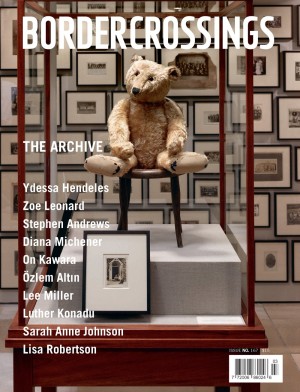Thirteen Easy Pieces
Landscape and the Canadian identity are a horse and carriage proposition; you can’t seem to have one without the other. A recent exhibition in the Project Space at Museum of Contemporary Canadian Art in Toronto adds a new twist to our understanding of the connections between the two, and in the process offers a model of smart, no fuss curating. Chosen by David Liss, MOCCA’s Director, and Josée Drouin-Brisebois, the Curator of Contemporary Art at the National Gallery, “Spectral Landscape” includes works on paper by an unconventional trio of artists: Sarah Anne Johnson, Tim Gardner and Peter Doig.
The Project Space is a collaborative venture between the two galleries and the tendency is to link the exhibition there to the main exhibition at MOCCA. So the tone and cinematic character of the main show, Tasman Richardson’s Necropolis, got David Liss thinking about Peter Doig. The installation takes the form of a dark, immersive video maze and the connection with Doig was instinctive. “In Doig there is a kind of hallucinatory experience between reality and fiction,” Liss says, “which corresponds to where we are at as a species, as people. I feel like we’re suspended between nature and technology and there is an ambiguity about this relationship.” He sees evidence of that tension in the seven etchings from Doig’s “100 Years Ago” series. “They’re landscapes but they’re not real. Because of the colouration they seem more like psychic landscapes.”
Drouin-Brisebois is equally interested in the psychological spaces the artists occupy. “I could see where David was going with this hallucinatory sense that is evoked in the works themselves. I started thinking about Sarah Anne’s work and its similar relationship to the landscape. There is a sense of utopia or something very celebratory, but the flip side of that can be dystopic, bizarre and very disturbing.”
Drouin-Brisebois sees Gardner as the oddest fit into this spectral context. “His works could be read straight; just a figure in a landscape or a tent on the beach. But there is something strange in those works, and I do sense that he has an interest in things that are not quite right.” In Untitled (Bryan with Hot Dog) you can see her point. On the surface, a young man on an early evening wiener roast turns to look behind him. What would be a casual gaze becomes an apprehensive one; what is he looking at? In this view, the food on the top of the cooler seems too compressed, the plastic cups are too tight, the Brâncuşi kiss of the ketchup and the relish bottles turns from the comic to the uncomfortable.
In the exhibition, the 13 works on paper, all of which are connected to photography, begin to talk to one another in persuasive and unsettling ways. Imperceptibly, an innocuous surfer climbing out of the ocean and onto a rock seems threatening; a vibrant sunset turns lurid; and you wonder just what the overexposed drifter is doing in town. Nothing can be read simply. As Drouin-Brisebois points out, all the figures in these works, whether arctic observer or drifter, are solitary. “If you have two people, it’s about leisure; if you have only one person, it’s about isolation and we’re not sure what’s going to happen.”
Her co-curator agrees. Gardner’s Above the Blowhole shows a single skier walking in a white landscape. “When you’re skiing,” Liss says, “you understand the imminent danger he can be in and, to add to the sense of foreboding, the composition seems to be a vortex that is sucking down into that blowhole. He’s another human being and his position in relation to technology and nature is to be suspended right in the middle.”
“Spectral Landscape”** is on exhibition at MOCCA from February 4 to April 1, 2012.

